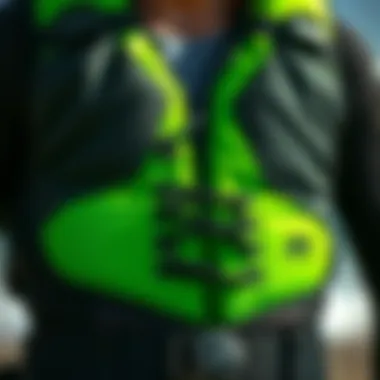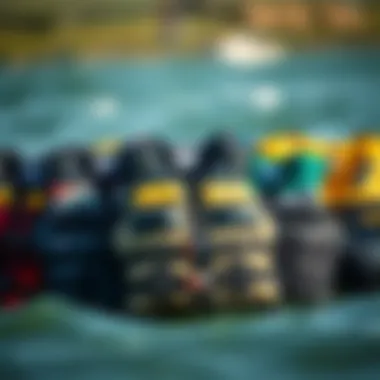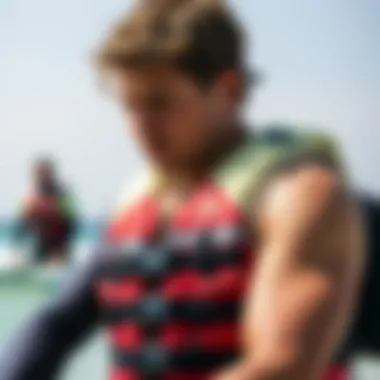Essential Guide to Flotation Vests for Kiteboarding


Intro
Kiteboarding, a sport that marries the power of wind with the thrill of gliding over water, offers immense excitement. However, just as one does not jump into the deep end without knowing how to swim, engaging in kiteboarding demands an understanding of safety gear—specifically, flotation vests. These vests are not merely accessories but essential gear that can significantly affect your safety enjoying the waves and wind.
When choosing a flotation vest, it's crucial to consider its design and functionality, suited to the conditions or your skill level. With the right gear, one not only enhances their security while kitesurfing but also boosts overall performance. Throughout this guide, we’ll unravel the ins and outs of flotation vests, exploring diverse types, maintenance tips, and regulatory standards, ensuring all kiteboarders can make educated decisions on their gear.
As we sail through the sections, we'll touch on how to pick the perfect vest and the importance of caring for your equipment. Whether you're a novice trying to get off the ground or a seasoned pro looking to optimize your ride, understanding flotation vests is pivotal. So grab your kite and let’s dive into this important piece of equipment that keeps us safe on the open water.
Importance of Flotation Vests in Water Sports
Flotation vests are not simply accessories in water sports; they are essential lifelines that can mean the difference between a safe adventure and a potential disaster. Their significance becomes particularly pronounced in activities like kiteboarding, where the nature of the sport combines high speeds with unpredictable conditions. These vests are designed to keep individuals buoyant, aiding them during instances of exhaustion or unexpected falls into the water.
Understanding Personal Flotation Devices
Personal Flotation Devices (PFDs), commonly known as flotation vests, play a pivotal role in outdoor sports. The primary function of these devices is to provide buoyancy, allowing a person to stay afloat in water. Moreover, they are designed to prevent drowning, particularly when the wearer is incapacitated or disoriented. For kiteboarders, the effectiveness of a flotation vest is doubly critical. One moment you might be gliding smoothly, and the next, a powerful gust of wind can send you crashing into the water. In these scenarios, having a well-fitted flotation vest can prevent panic and provide a moment to regain control, which can be invaluable.
The Role of Safety Equipment in Kiteboarding
Kiteboarding, while exhilarating, carries inherent risks due to the unpredictability of water and wind conditions. Therefore, employing the right safety equipment, especially flotation vests, can greatly enhance safety. Think of it this way: a flotation vest is like your security blanket on the water. It reassures you that if things go sideways, you have something to keep you above water.
Moreover, many people might underestimate the physical demands kiteboarding can impose. Riders often face fatigue, especially in challenging conditions. A flotation vest is crucial here. It offers not only buoyancy but also thermal protection and impacts resistance in case of a fall. Ultimately, the presence of a flotation vest invites confidence; it encourages kiteboarders—whether seasoned pros or novices—to push their limits while knowing they are protected. As you gear up for a kiteboarding session, remember: the water is full of surprises, and being prepared is the best strategy.
It's important to choose a flotation vest that fits well and meets safety standards to ensure maximum protection and comfort.
Types of Flotation Vests
Understanding the various types of flotation vests is essential for kiteboarders to ensure safety and enjoyment while riding the waves. Each type of vest has unique design features and capabilities that cater to different skill levels and riding conditions. The right flotation vest not only enhances safety but also contributes to the overall kiting experience. Here, we’ll delve into key distinctions among different flotation vests, helping you make an informed choice.
Buoyancy Aids vs. Flotation Vests
When it comes to water sports, some might wonder what distinguishes a buoyancy aid from a flotation vest. Both serve a similar purpose of providing additional support in the water, but their designs and intended uses vary greatly.
- Buoyancy aids are generally lighter and less restrictive. They are designed to keep a user's head above water, making them ideal for situations where mobility is key, like in freestyle kiteboarding. However, they usually provide less overall floatation and protection than more robust flotation vests.
- Flotation vests, on the other hand, combine buoyancy with a design that allows for added protection against impacts. They often include features like higher waistbands and extra padding, which can be crucial in choppy waters.
In summary, if you're looking for flexibility and freedom of movement, a buoyancy aid might suit your needs. If you're leaning towards safety and protection, especially in waters that are unpredictable, then a flotation vest is your best bet.
Inflatable vs. Non-Inflatable Vests
Choosing between inflatable and non-inflatable vests can feel a bit like picking your favorite ice cream flavor. Each has its perks and potential drawbacks.
Inflatable vests, as the name suggests, contain an air chamber that inflates upon activation, offering buoyancy when needed. This has the advantage of being relatively lightweight and less cumbersome during kiteboarding sessions. However, they require more maintenance and might be less reliable if there’s a malfunction.
Non-inflatable vests, conversely, are constructed from foam or similar materials that ensure consistent buoyancy. They’re ready to go at a moment's notice without the need for activation. Nevertheless, some riders might find them bulkier or less comfortable during extended wear.
Minimalist Designs for Experienced Riders
For the seasoned kiteboarder, a minimalist flotation vest can offer a welcome change from bulkier models. These designs focus on enhancing movement without skimping on safety.
Such vests are crafted to hug the body snugly and often feature thinner materials that don’t compromise on buoyancy. They’re ideal for riders who have mastered their skills and want to feel more connected to their kite and board.
- Benefits of Minimalist Vests:
- Enhanced freedom of movement
- Reduced bulk for better aerodynamics
- Often lighter, making for less fatigue during long sessions


This minimalist approach allows advanced riders to maneuver freely while still retaining a safety net should the unexpected arise.
Recreational versus Competition Vests
The choice between recreational and competition vests boils down to the specific needs of the rider and the environment in which they plan to kiteboard.
Recreational vests are designed for casual riders who enjoy kiteboarding as a hobby. They often emphasize comfort and general safety, offering a decent level of buoyancy without overwhelming features that may not be necessary for occasional use.
In contrast, competition vests are equipped with features suited for advanced performance, such as optimized buoyancy configurations, lightweight materials, and even streamlined designs to cut through wind resistance. These vests might also adhere to specific regulations set by competitive organizations to ensure safety standards.
Ultimately, selecting between recreational and competitive vests involves assessing your personal kiteboarding goals and expectations.
In summary, understanding the various types of flotation vests is essential for kiteboarding safety and enjoyment. Each type has its own advantages, catering to different riders and conditions, so be sure to choose wisely!
For more specialized insights into kiteboarding safety and flotation devices, resources like Wikipedia and Britannica provide comprehensive overviews.
Features to Consider When Selecting a Flotation Vest
Choosing the right flotation vest is not just about style; it’s about safety and functionality. A well-chosen vest can enhance your kiteboarding experience, providing peace of mind as you tackle the waves. Not all vests are created equal, so it's important to consider specific features that cater to individual needs and conditions. Here, we explore essential elements that you should prioritize when selecting a flotation vest, ensuring a well-rounded decision-making process.
Size and Fit
One of the most critical factors to consider is the size and fit of the vest. A vest that does not fit properly can lead to discomfort or, worse, can hinder your safety in the water.
- Personal Comfort: A snug fit ensures that the vest doesn’t ride up or shift during your ride. You want to achieve a balance where the vest is secure yet comfortable.
- Universal Sizing: Watch out for vests that come with universal sizing guides. These can be helpful but often result in a compromised fit.
- Try Before You Buy: If possible, put the vest on and simulate movements similar to those in kiteboarding. If it feels too tight or too loose in any way, it’s probably not the right fit.
Material Durability
The materials used in the construction of flotation vests contribute significantly to their durability and overall safety. You want to ensure that the vest can withstand the rigors of kiteboarding.
- Water Resistance: High-quality flotation vests are often made from water-resistant materials that can fend off puddles and wetness, keeping you dry as possible.
- Quality Testing: Look for vests made from recognized durable materials such as nylon or neoprene. These are often more resistant to wear and tear compared to cheaper alternatives.
- UV Protection: Especially if you’re out in the sun, check if the materials have UV resistance, which can prevent material degradation over time.
Adjustability and Comfort
Every rider is different, and so are their comfort preferences; thus, adjustability becomes key when selecting a vest.
- Straps and Buckles: Vests equipped with adjustable straps allow for a personalized fit. This is particularly beneficial when wearing layers underneath.
- Ease of Use: Consider how easy it is to adjust the vest. Straps that require minimal effort to tighten or loosen can be a game-changer when you’re gearing up.
- Breathability: Opt for vests with ventilation or breathable materials, which can keep you cooler, especially in warm conditions.
Visibility Features
Being seen is paramount, no matter the adventure. Visibility features play a crucial role in enhancing your safety on the water.
- Bright Colors: Choosing a vest with bright colors can help you stand out against the backdrop of the sea, improving visibility for others while you kiteboard.
- Reflective Strips: Vests that include reflective strips can also assist with visibility, especially in low-light conditions, like early morning or sunset sessions.
- Personal Lighting Options: Some modern vests come with attachment points for personal lights, adding another layer of visibility if you plan to ride after dusk.
Keep in mind that your safety gear isn't just a piece of equipment; it's a vital part of your kiteboarding experience.
Selecting a flotation vest with the right features can significantly impact your enjoyment and safety on the water. Each detail matters, from fit to material durability, adjustability, and visibility. Balancing these features based on your personal needs and riding style is essential in making informed decisions as you delve into the thrilling world of kiteboarding.
Kiteboarding Conditions and Flotation Vest Compatibility
Kiteboarding presents a thrilling yet unpredictable environment, making flotation vest compatibility crucial for safety and performance. Kiteboarders interact with wind, water, and waves that can fiercely change within moments. Hence, understanding how different conditions influence flotation vest choice is imperative. Lighter winds might not demand as robust a vest, while tumultuous seas warrant functional designs that prioritize security.
Choosing for Calm Waters
In calm waters, kiteboarding can feel akin to gliding on a serene lake. Here, the choice of flotation vest can pivot toward minimalistic designs that offer mobility without compromising safety. A vest that boasts lightweight materials and a snug fit can enhance your freedom of movement, allowing you to perform tricks without feeling hindered.


When selecting a vest for these tranquil conditions, consider the following:
- Buoyancy Rating: Ensure the vest provides appropriate buoyancy that suits your skill level. If you're a beginner, opt for a higher buoyancy vest for added safety.
- Size and Fit: A snug fit is vital. You want the vest to stay secure while you navigate the calm waters.
- Visibility: Even in calmer settings, visibility can play a role. Bright colors make you more noticeable to passing boats or fellow kiteboarders.
Dressing for Rough Seas
When facing the wrath of rough seas, the selection of a flotation vest shifts dramatically. The focus here needs to be on sturdiness and functionality. It's no longer just about buoyancy; the vest must resist the harsh elements to keep you afloat and protected. A vest designed for these conditions often features reinforced sections, extra padding, and strategic shaping to enhance resistance against waves.
Here are several considerations for selecting a vest in this scenario:
- Built for Impact: Look for vests made with thicker, durable materials that can withstand waves and potential collisions.
- Secure Fastening: A vest that stays put when you're tossed by choppy waters is essential. Fiddly zippers or weak straps could lead to disaster.
- Adjustability: Consider vests with adjustable straps, allowing for a tailored fit that won't shift during your ride.
Impact of Wind Conditions on Flotation Needs
Wind conditions have a dramatic impact on your performance and safety in kiteboarding. In lighter winds, a less robust vest may be suitable as the likelihood of being tossed into the water is lower. However, as winds pick up, you need to consider vests designed to keep you buoyant and secure.
- Light Winds: You might choose a vest that offers a subtle buoyancy aid, as you won’t require extensive assistance while riding these breezes.
- Strong Winds: Here, opt for full flotation vests that accommodate for loss of control due to unexpected gusts. Sporty vests with added features—like flotation enhancement pods—can dramatically improve your safety.
As a rule of thumb, always adjust your flotation vest choice according to wind strength and water conditions. By aligning your gear with the environment, you can navigate kiteboarding with a sense of security and enjoyment.
"Adjusting your gear based on conditions isn't simply smart—it's essential for your safety on the water."
For additional information, you may explore resources on kiteboarding safety at Wikipedia and National Oceanic and Atmospheric Administration.
Maintenance and Care of Flotation Vests
Taking care of your flotation vest is as important as selecting the right one and using it correctly. Regular maintenance ensures its buoyancy features and structural integrity remain intact, thereby providing safety when you hit the water. It’s not just a case of keeping your gear looking sharp; it’s about preserving the life of the vest. Proper care helps you avoid unexpected malfunctions that could compromise your safety in potentially perilous conditions.
Cleaning and Storing Your Vest
To maintain the quality of your flotation vest, begin with a simple cleaning routine. After each use, rinse the vest in fresh water to eliminate salt, sand, or any residue that might have clung to it. Saltwater and sand can slowly erode the material and diminish the vest’s buoyancy.
Store the vest in a cool, dry place away from direct sunlight when not in use. Prolonged exposure to UV rays deteriorates materials and reduces their effectiveness. A cloth bag or mesh storage system is often a good choice for storage, allowing for airflow and preventing mold growth. Then, you can stash your vest in a spot that’s cool and hidden from the sun—this goes a long way in keeping it in top shape.
Inspecting for Wear and Tear
Every season, or even after intensive use, it’s crucial to conduct a thorough inspection of your flotation vest. What you’re looking for are signs of wear and tear—frayed straps, cracked buckles, or compromised seams. These small issues could escalate if left unattended. Even a minor rip can create a critical failure when you need maximum buoyancy.
Don’t hesitate to take a good hard look at the inside of the vest too. If you notice the padding is becoming less buoyant or deformed, it may be time to replace it. This can often mean the difference between a safe ride and a risky plunge.
"Inspecting your flotation vest isn’t just about keeping up appearances; it’s about ensuring your safety on the water. Never skip this step!"
Lifespan Considerations
Knowing when to retire a flotation vest is a vital part of water sports safety. Typically, a well-cared vest can last anywhere from three to five years; however, this varies based on frequency of use and quality of the materials involved. If you’re a weekend warrior, you might find your vest remains in great shape longer than if you hit the waves daily.
Check the manufacturer’s recommendations for lifespan and maintenance tips, but don’t ignore visible signs of deterioration. When in doubt, err on the side of caution. You value your safety—don’t hang onto a vest past its prime. Being proactive about replacing your vest can save you from potentially dangerous situations in the foam and spray of the sea.
By paying attention to cleaning, inspections, and lifespan, kiteboarders can ensure that their flotation vests are not just an afterthought but a reliable and essential part of their safety gear.
Legal Requirements and Standards
Understanding the legal requirements and standards related to flotation vests is not just a matter of compliance; it's essential for ensuring the safety of kiteboarders. These regulations serve as a framework to guarantee that equipment meets certain safety standards, thus providing the necessary protection against the unpredictable nature of water sports.
When kiteboarding, the sea can be as fickle as the wind. Having a properly certified flotation vest enables riders to face challenges, both expected and unforeseen, while enjoying peace of mind. By adhering to these guidelines, kiteboarders can significantly reduce risks during their thrilling exploits.


Local Regulations Regarding Flotation Devices
Local regulations about flotation devices vary significantly across regions, often influenced by geographical factors and environmental considerations. For instance, a coastal area known for its gentle waves will likely have different guidelines compared to a region with roaring surf. Given these variations, familiarizing oneself with local laws is paramount.
- Consult Local Authorities: It is wise to check with local governing bodies or websites like *.gov for updated regulations on flotation vests. This may include size requirements, buoyancy levels, and specifications for personal flotation devices.
- Common Restrictions: In many regions, flotation vests must be Coast Guard approved, meaning they meet specific buoyancy and craftsmanship standards. Some places may mandate brightly colored vests for better visibility.
- Event-Specific Rules: Events or competitions may have their own rules on flotation vests that differ from general safety guidelines. Being well-informed can save riders from potential disqualification.
Kiteboarders must ensure that their flotation vest complies with both local and event-specific regulations to ensure safety and avoid legal repercussions.
International Standards for Kiteboarding
On a broader scale, international standards aim to unify safety measures across borders, providing kiteboarders with a consistent frame of reference regardless of location. Organizations such as the International Standards Organization (ISO) set guidelines that manufacturers must follow when producing flotation devices. These standards might include:
- Buoyancy Requirements: Vest designs must promote sufficient buoyancy, which is crucial in emergencies. Compliance with ISO standards ensures a minimum buoyancy level for optimal performance.
- Material Specifications: International standards often dictate specific materials to be used in the construction of flotation vests to enhance durability and ensure longevity. These materials are tested to withstand harsh marine conditions.
- Testing Protocols: Rigorous testing protocols help in ensuring that flotation vests can endure real-world kitesurfing situations, from drag forces during high-speed rides to splash impacts.
Adhering to these international standards not only benefits individual riders but also promotes a culture of safety throughout the kiteboarding community.
"Safety regulations are like the wind; when you respect and understand them, they propel you forward. When ignored, they can steer you off course."
While the excitement of kiteboarding often attracts adventure seekers, understanding the legal landscape and safety regulations surrounding flotation vests has become a crucial aspect of responsible riding. Riding with knowledge of these standards and regulations ensures not only personal safety but also enhances the experience on the water.
Community Insights and Experiences
Community input can be the backbone of kiteboarding safety discussions, especially regarding flotation vests. The shared stories and experiences among kiteboarders provide crucial insights not only into the efficacy of various vests but also into the reality of riding conditions. When it comes to safety gear like flotation vests, first-hand experiences can shed light on what tends to work and what does not. It’s in the exchange of these narratives where learning truly flourishes.
By tapping into the kiteboarding community, individuals can glean priceless information that goes beyond mere specifications. They can explore how different vests held up during actual use under varying conditions, revealing potential flaws or advantages that manufacturers might not always highlight. Engaging with fellow riders offers a path to safer choices and ultimately infuses confidence into your kiteboarding adventures.
Testimonials from Kiteboarders
Testimonials serve as valuable indicators of the reality of flotation vests in action. Here, contributors discuss their experiences, reflecting on aspects such as comfort, buoyancy, and overall reliability.
Many kiteboarders emphasize the importance of fit and adjustability in their testimonials. For instance, Monty, an avid kiteboarder from California, shares, “When I shifted to a vest that truly fit me snug, everything changed. I wasn’t fighting the vest; it was working with me.” This highlights a vital point—comfort can significantly affect performance.
On the other hand, Elise from Florida recounts an incident where her flotation vest saved her from a potentially dangerous situation. “I was caught off guard by a strong gust, and I fell hard. My flotation vest gave me enough buoyancy to stay above water. I can’t recommend it enough.” Such experiences underscore the necessity of reliable flotation devices when the winds pick up.
Future Innovations in Flotation Vest Design
The world of kiteboarding is always changing, and the gear we use keeps on evolving too. Flotation vests are no exception to this trend. This section explores the exciting innovations on the horizon for flotation vest designs. As safety and performance intertwine, it's clear that advancements in technology and materials will not only enhance safety but also boost comfort and usability in unrestricted environments.
Technological Advancements
In recent years, we have seen a surge in technological advancements that aim at improving flotation vest designs. For instance, some manufacturers are exploring the integration of smart technology into flotation vests. Smart vests might feature sensors that can monitor the wearer’s heart rate, hydration levels, and even body temperature. Such information could be crucial, especially for those spending lengthy sessions on the water. Imagine knowing when to take a break without relying solely on your instincts.
Moreover, developments in buoyancy foam are also noteworthy. New foam materials are being created that are not only lightweight and comfortable but also more effective at providing buoyancy without the bulk often associated with older models. These innovations allow kiteboarders to enjoy greater freedom of movement, which is essential when performing tricks or navigating through challenging waters.
"Innovation in flotation vest design is not just about safety; it’s about enhancing the overall experience of kiteboarding by combining comfort, performance, and technology."
One cannot overlook the possibility of enhanced visibility features in flotation vests. With advancements in LED technology, vests could incorporate lights that activate during low-light conditions, further aiding on-water safety. This can make a significant difference, especially during early morning or late evening sessions when the waves are still inviting but visibility is limited.
Sustainability Trends in Materials
Sustainability is a crucial consideration in today’s market. Kiteboarders, like many consumers, are becoming increasingly aware of the environmental impact of their gear. Upcoming flotation vests are part of this shift towards eco-friendliness. Companies are beginning to utilize recycled materials to produce vests, which reduces waste and promotes the use of eco-conscious manufacturing techniques.
Additionally, there’s a push towards biodegradable materials that can decompose if discarded improperly. This not only minimizes the environmental footprint but also reassures kiteboarders that they are making responsible choices with their gear. Some brands are experimenting with natural fibers and sustainable manufacturing processes, which could redefine the standards for what materials are acceptable in flotation vest production.
Kiteboarding enthusiasts must stay updated on these trends, as choosing sustainable options often reflects a broader commitment to protecting the environments where they enjoy their sport. The next wave of flotation vests might not only keep you safe but also help keep our oceans clean.















